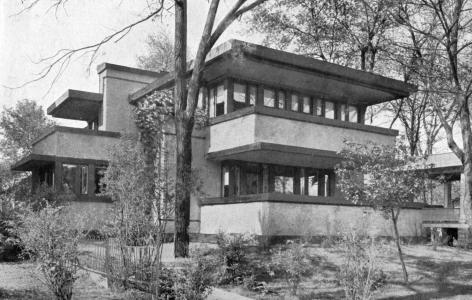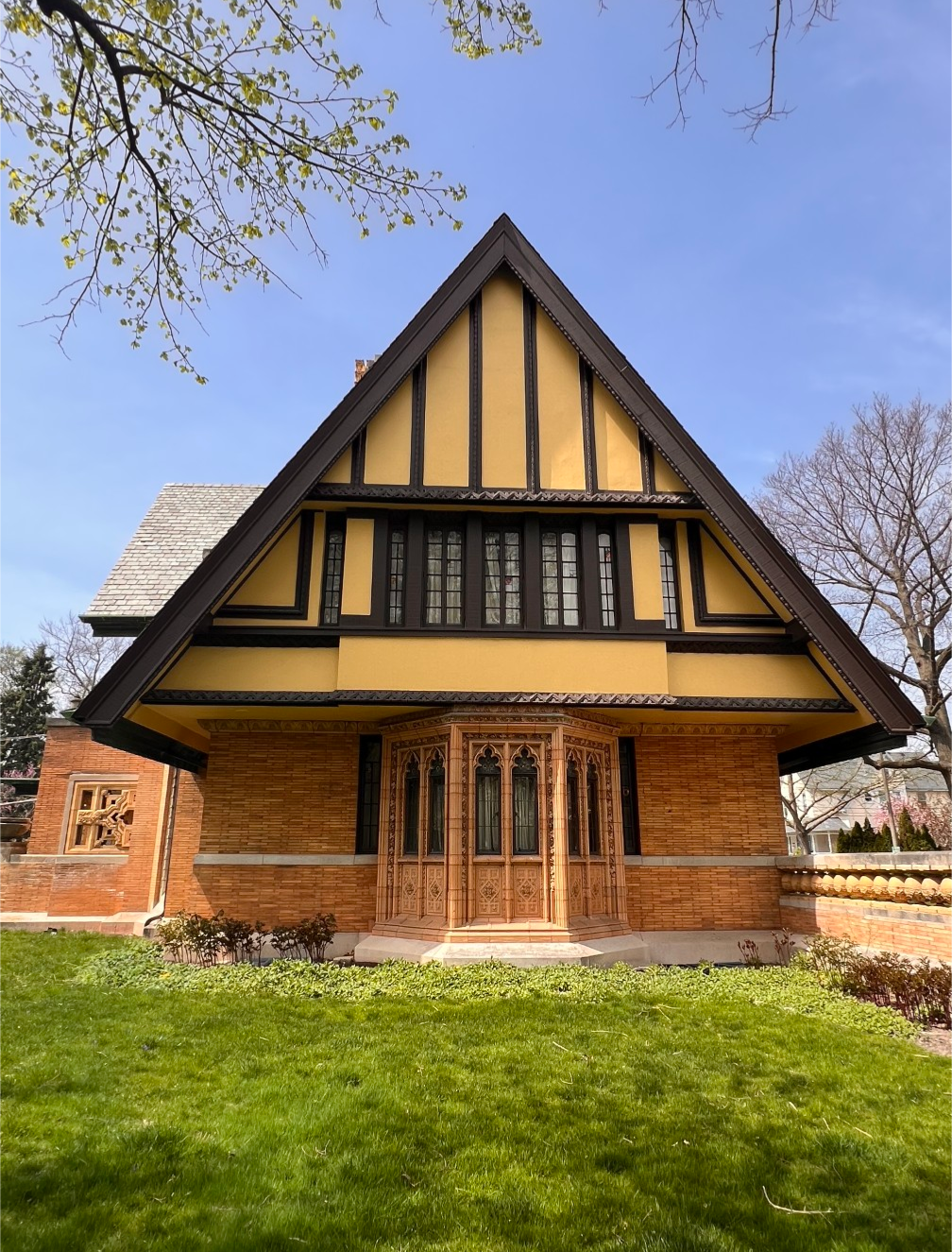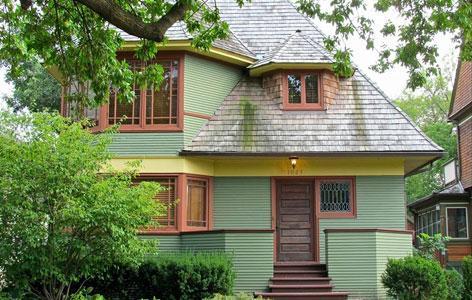The village of Oak Park is home to the world's largest collection of Frank Lloyd Wright works—from private homes to public buildings—making it one of the most significant destinations for American architecture in the 20th century. This treasure trove includes his Home and Studio, where he conceived of the Prairie School, to Unity Temple, his only surviving public Prairie-style building, to beautifully preserved private residences built during his most prolific period. While you might expect to find many Wright sites in New York, California, or Arizona, the greatest concentration is right here in Illinois.
Oak Park: At the Heart of Wright’s Legacy
Oak Park’s Historic District contains the highest number of Wright-designed residences in the world, including the Frank Lloyd Wright Home and Studio, where the celebrated architect lived and worked during the first 20 years of his career. This square foot of history offers an intimate glimpse into the life of a man whose designs—from the Guggenheim Museum in New York to the Hollyhock House in Los Angeles—are recognized globally. Many of these buildings, along with Taliesin West in Scottsdale, Arizona, and Taliesin in Wisconsin west of Milwaukee, appear on the UNESCO World Heritage List of Wright sites, celebrated for their impact on architecture worldwide.
Why Oak Park?
Frank Lloyd Wright received a loan from his employer, architect Louis Sullivan, to purchase Oak Park land and begin the first project over which he had complete artistic control. Wright used his home for extensive experimentation—revising the floor plan multiple times and refining ideas that would influence later masterpieces like the Martin House in Buffalo and Fallingwater in Pennsylvania, the Kaufmann family’s home near Pittsburgh. Once a rural community, Oak Park was then becoming a hub for wealthy industrialists and professionals whose commissions helped Wright build his reputation and evolve his style.
In 1898, Wright expanded his home with a four-room addition that became his studio, private office, library, and reception hall for the next 11 years. Fourteen associates worked alongside him in the dramatic, two-story octagonal drafting room. The Oak Park Studio years were among the most productive of his career, when he developed his own interpretation of the Arts and Crafts movement into the Prairie style. His approach was influenced by Japanese design principles, which favored harmony, simplicity, and a deep connection between a building and its surroundings.
What Makes a Frank Lloyd Wright House Unique?
The Prairie style was one of America’s first distinct architectural movements, characterized by horizontal lines, flat roofs, and deep overhanging eaves that echoed the broad, open expanses of the Midwestern prairie. Wright’s design philosophy emphasized “organic architecture”—the idea that every element of a building, from the floor plan to the living room furniture, should feel like a natural extension of its surroundings and each other. Art glass, walls of windows to maximize natural light, high-backed chairs, and open interiors helped blur the line between indoor and outdoor spaces.
Wright pushed the envelope of American architecture in many ways. Instead of traditional lead, he used zinc dividers for windows and was among the first to incorporate glass bricks, custom-made electric light fittings, and spherical lampshades. Whether in a compact Usonian home for the middle-class or his iconic Robie House in Illinois, his work displayed a minimalistic, functional approach—eliminating unnecessary details to create elegant homes without clutter.
How to Spot a Wright
While no two structures designed by Wright are the same, common design features can be seen in all his homes. Here are some of the key design features you will find in a Wright building as you wander around Oak Park:
-
long, low horizontal lines
-
low-pitched roofs with deep overhangs
-
natural materials such as native sandstone
-
bold geometric shapes, with polygonal window bays
-
generous use of large windows and glass walls
-
central hearth or fireplace
Highlights from the Frank Lloyd Wright Collection in Oak Park, IL
Frank Lloyd Wright designed countless works, but some of our very favorite are right here in Oak Park!


.jpg)
Arthur Heurtley House (318 Forest Avenue, Oak Park, IL) was commissioned by one of Wright’s wealthier clients and is considered one of the earliest examples of the Prairie style. A nearly uninterrupted ribbon of art-glass windows runs beneath the large overhang of the house’s hipped roof. This is a private residence; tours are not available.
Edward R. Hills House (313 Forest Avenue, Oak Park, IL) was purchased by one of Wright’s clients as a gift for the client’s daughter and her husband, Edward R. Hills. Wright’s modifications included reorienting the structure on its site, adding two verandas on the first floor, and finishing the exterior of the house in stucco with dark wood trim. When the house caught fire during a restoration project in 1976, it was painstakingly rebuilt. This is a private residence; tours are not available.
Frank Lloyd Wright Home and Studio (951 Chicago Avenue, Oak Park, IL) is the home of all homes and the birthplace of the Prairie School of architecture and where Wright designed and completed roughly a quarter of his life’s work. Guided tours are available with the Frank Lloyd Wright Trust.



Laura Robeson Gale House (6 Elizabeth Court, Oak Park, IL) is a stunning stucco-and-wood home built on a narrow, winding street. A Roman brick fireplace anchors the main floor, while cantilevered balconies and roofs hint at Wright’s later masterpiece, Fallingwater. This is a private residence; tours are not available.
Nathan G. Moore House (333 Forest Avenue, Oak Park, IL) is the only Tudor-style home Wright designed, and he wasn’t happy to have been hired to mimic a historic design. When a fire destroyed the third floor, Wright agreed to do the renovation and made some changes that pleased him, including opening up the second floor and adding a second-floor terrace. This is a private residence; tours are not available.
Thomas Gale House (1027 Chicago Avenue, Oak Park, IL) is known as a “bootleg house”; not allowed to take outside commissions while employed by Adler & Sullivan, Wright designed this home and others in secret. The Queen Anne-style clapboard structure has a high-pitched roof, octagonal dormers, a bay window, and horizontal bands of windows. This is a private residence; tours are not available.
Click here for complete map of all of the homes!
And although its not a home, you won’t want to miss Unity Temple (875 Lake Street, Oak Park, IL), Wright’s only surviving Prairie-style public building, known for its innovative design and unconventional materials. This “little jewel box,” as Wright called it, is still an active house of worship. Take a guided tour or explore it at your own pace.
The Ultimate Wright Tour
Frank Lloyd Wright Trust offers guided tours of Wright’s home and studio and Unity Temple, as well as a two-and-a-half-hour walking tour that looks at the exteriors of 10 homes (exterior) around Oak Park. The knowledgeable guides point out meaningful architectural details that you might otherwise overlook. You can also enjoy a self-guided audio tour of the surrounding historic district, which includes 25 Wright-designed buildings.
The always-sold-out Wright Plus House Walk every May provides rare glimpses inside these historic homes, and you can always take yourself on a self-guided walking, driving, or cycling tour of all the Frank Lloyd Wright homes in Oak Park with this map. The Frank Lloyd Wright Foundation also works to preserve and protect his most significant works nationwide, helping ensure these tours and landmarks remain available for future generations.
Note: Please remember not to disturb the families who call these stunning works of art home.
Make the Most of Your Visit
Set just west of Chicago, idyllic Oak Park, IL, with its historic sites, inviting restaurants, charming shops, and wide tree-lined streets, is truly a gem. Oak Park features several districts, each with its own unique character, including:
-
Lake Street Oak Park is a lively center of shops, restaurants, and entertainment.
-
Pleasant District, along South Marion Street, offers outdoor murals and is bursting with restaurants, jewelry stores, and antique shops.
-
Oak Park Arts District, a half-mile stretch on Harrison Street from Austin Boulevard to Ridgeland Avenue, is a thriving, entrepreneurial artist community.
-
Hemingway District, named for its native son, is perfect for strolling, biking, and experiencing locally owned specialty shops and restaurants.
Plan Your Visit Today
Located less than 10 miles west of downtown Chicago, Oak Park is easy and fast to get to. Take I-290 to either Austin or Harlem exits by car or the CTA Green Line from the Loop, which offers four convenient stops along Oak Park’s bustling Lake Street corridor. The Oak Park Metra station puts you in the heart of downtown. Visit in the fall, when tree-lined streets provide a brilliant canopy of reds and yellows, or in the summer, when village museums expand their walls to the great outdoors and concerts, festivals, and other special events add even more to make your visit worth the trip.
Ready to walk in the footsteps of a legend? Check out our complete map of Frank Lloyd Wright homes in Oak Park and start your exploration.
.png?length=1440&name=OP&B%20-%20Blog%20post%20banners%20(7).png)